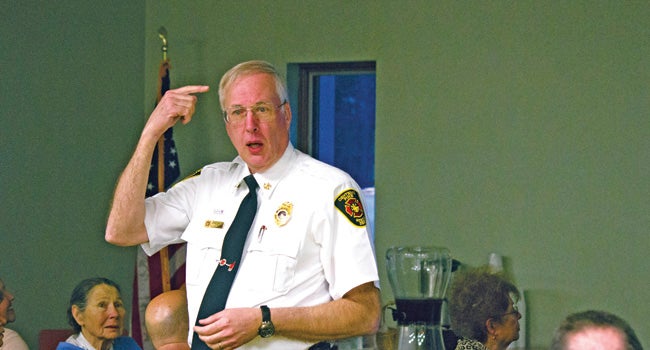Dowagiac native recounts lessons learned from massive I-94 accident
Published 8:00 am Tuesday, April 11, 2017

- Oshtemo Township Fire Chief and Dowagiac native Mark Barnes talks about his experiences during the massive car pile up on Interstate 94 outside Kalamazoo in 2015. Barnes spoke during the Wayne Township Fire Department’s annual dinner Saturday evening. (Leader photo/TED YOAKUM)
The morning of Jan. 9, 2015, got off to a rather slow start for members of the Oshtemo Township fire department.
With schools and governmental offices closed due to the severe snowstorm that plowed through southwest Michigan that day, Chief Mark Barnes and his crew on duty expected to spend the day catching up on cleaning his department’s vehicles and firehouse. Due to the whiteout conditions outside, Barnes expected most people to spend the day tucked away inside their homes and off the streets.
“Most folks do [stay home],” Barnes said. “Those that don’t are not driving so fast that they typically get really hurt. I don’t get a lot of calls on these days.”
However, the tranquil start that morning was shattered by one of the most destructive vehicle pileups in recent memory.
The Oshtemo department was one of 11 area fire agencies that responded to a massive 193-vehicle accident on Interstate Highway 94 outside Galesburg in Kalamazoo County that morning. The chaos left one person dead and nearly two dozen more injured, and required two days worth of cleanup and extensive coordination between area and state agencies to reopen the stretch of highway.
Barnes, a native of Dowagiac, shared his experiences and the lessons he and other emergency personnel learned from the horrific accident to attendees of the Wayne Township Fire Department’s 30th annual Firefighter Recognition Dinner Saturday. Around 100 people gathered inside the township hall that evening for the dinner, including current and retired Wayne Township firefighters and members of the fire and township boards.
The accident occurred on a stretch of I-94 between Kalamazoo and Battle Creek that has extremely high traffic volumes, Barnes said. The visibility outside was zero miles — a total whiteout, Barnes said.
A total of 117 personal vehicles and 76 semis were caught up in the pileup — most of which crashed in the westbound lane of the highway, in spite of the fact the pileup began in the eastbound one, Barnes said.
On top of dealing with injuries and the wrecked vehicles, firefighters and towing crews also had to contend with flammables that caught ablaze or chemicals seeping from the destroyed semis. One of the semis was carrying fireworks, and was shot explosives for nearly a week after the crash, requiring emergency personnel to tow the vehicle to a secluded part of a nearby National Guard training facility, Barnes said.
“Toward the end of the week, it was just spurting every once in a while, but one spurt upside your helmet is not a good deal,” Barnes said.
In spite of the carnage, first responders were able to take away several key lessons, which can assist emergency planners and personnel living anywhere in the state or country.
One of the takeaways was ensuring the public at large remains informed through coordinated public outreach, Barnes said. During the weekend of the accident, a total of three officers with the Michigan State Police handled all contact with the media, including press releases and conferences.
“There [is] nothing more impressive than seeing a Michigan State Trooper, dressed all prim and proper, stare in front of the camera and say, ‘This is what is happening. We’re here and we’re going to take care of you,’” Barnes said.
However, in order to effectively reach the press, these officers cannot remain behind at a firehouse or emergency center — they must head out to the field, where reporters and photographers will be, Barnes said.
Coordinating with local school districts, public transit and other agencies is also a must, Barnes said. Emergency personnel were able to use the local high school that day as a gathering point for stranded drivers, using buses from Kalamazoo to transport people from the scene of the accident.
Getting the community involved with relief efforts is also helpful, as area residents were more than willing to pitch in that weekend to offer food, supplies and comfort to victims, Barnes said.
“That was worth a million,” he said. “It was really wonderful.”
The accident also highlighted the importance of working and coordinating with different agencies, as well as having a centralized system of control on the scene to ensure the safety of emergency personnel and civilians, Barnes said.
“Firefighter and first responder safety is absolutely ultimate,” he said. “If I save citizens and kill firefighters, I have not done my job.”






